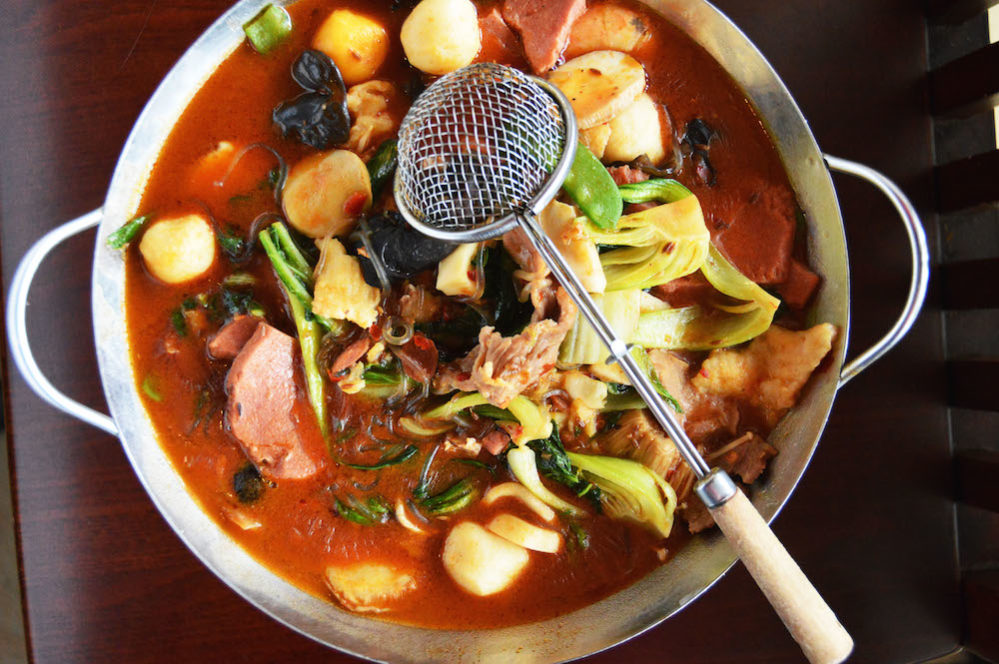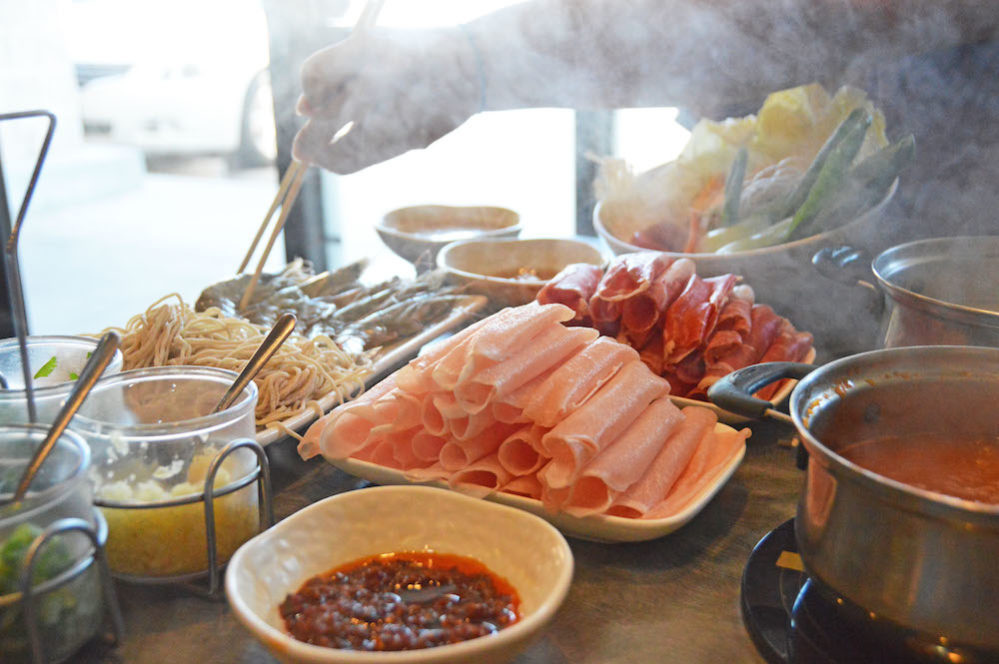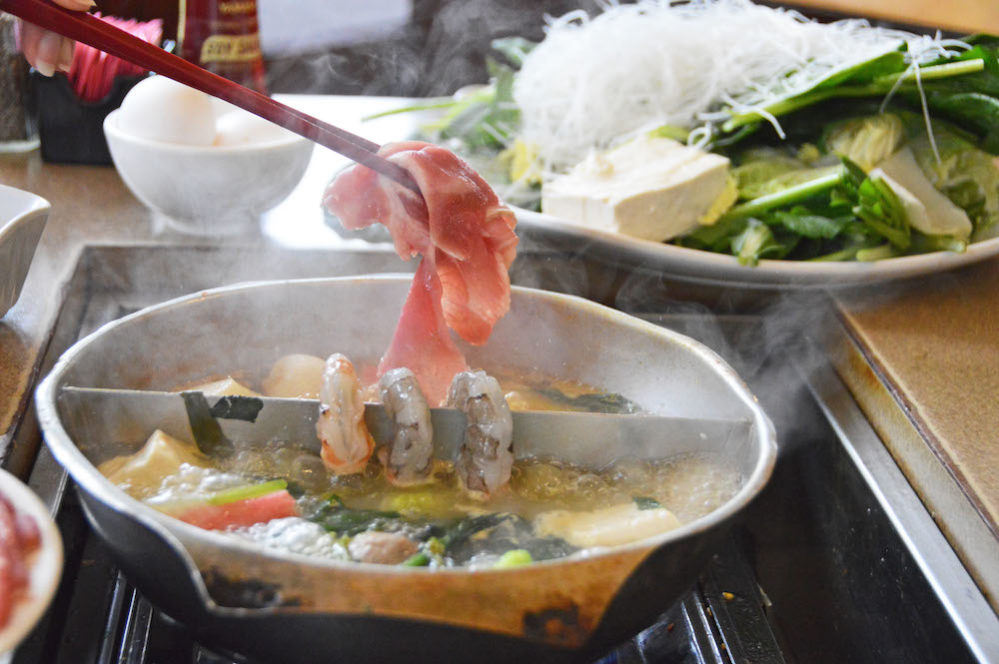It’s easy to understand why dining at a restaurant that features hot pot might be intimidating to the uninitiated. There is the awkward table with an open flame, boiling broth, platters of raw ingredients and special cooking utensils. Sometimes a language barrier can add confusion or anxiety. How do I order? What if I don’t like something? Do I eat straight from the pot or from the plate? Consider this primer a starting point for where to go and how to enjoy one of the most filling – and fulfilling – meals in Houston’s Asiatown.
Hot Pot History
As with most things, the exact invention of hot pot is lost in the mists of time, but many sources point to the Jin Dynasty in China over 1,000 years ago. The internet contains many references to resourceful Mongols using their helmets as cooking vessels and shields as cooking surfaces during their travels through northern China. The main food intended for the helmet hot pot was horse, sheep and cattle. Over the years, regional styles have evolved to reflect local ingredients, such as seafood hot pot on the coast. Cooking broths are also variable and include the southern Chongqing (also called the Sichuan version), which is a dark-red chili-infused liquid with the distinctive buzzy tingle of Sichuan peppercorns. A lighter, more neutral broth is popular in northern regions like Beijing.
How it Works
As with other communal foods – think of fondue, for example – it can be tricky to know the proper way to eat without stepping on some etiquette toes. The most important point is, unless you are dining with the closest of friends or family, don’t eat food directly from the pot. Instead, place cooked food on your plate or in your bowl. Courtesy also dictates you refrain from placing chopsticks directly into your mouth; do your best to let only your lips touch the food.
Because of the time involved with prepping, cooking and eating hot pot, the meal is reserved for lunch and dinner, not snacks. And while it’s not wrong to dine solo, the nature of hot pot typically dictates sharing with a group. It’s hard to say how many are too many, but large hot pots can easily serve six to eight people. On the quiet side, a hot pot for just the two of you can be downright romantic.
Many restaurants offer hot pots in pre-chosen combinations, but there is nearly always an option to order items a la carte as well. Vegetables like watercress, bok choy, Taiwan spinach and Napa cabbage typically come standard, while rice and noodles may also be provided. Whole raw eggs are also common.
Once the main order is placed, the server may ask what kind of broth you prefer, or he or she will simply deliver a pot that is separated in the middle to allow a spicy version and a mild version. Chinese, Vietnamese, Mongolian and Japanese hot pots (among others) will each offer distinct flavor profiles.
The pot is set on a gas burner, which may be in a recessed niche of the table, set level with the tabletop or be as simple as an electric hot pad. Once the broth is boiling, use chopsticks to drop in the meat or vegetable that you wish to cook and eat. The thinly sliced meats require only a very brief dunk to cook, so keep a watchful eye. Use the provided ladle or strainer to scoop up cooked food. Don’t forget about the fine rice noodles, either, which cook in mere seconds and turn to mush if you aren’t vigilant. Eggs can be broken and dropped in to cook in the broth, while some diners prefer to mix the raw yolk with chili sauce for dipping.
If dining with close friends or family, chopsticks are an acceptable retrieval method, but when in doubt use the provided ladles or woven-wire “spiders” to scoop out the goods. Drop bites onto your plate or into a small bowl of chili or soy sauces. When the broth runs low simply ask your server for a refill and carry on. Sip on hot tea or whatever beverage you wish; there doesn’t appear to be any single traditional beverage.
Where to Try a Hot Pot in Asiatown
SINH SINH 9788 Bellaire Blvd., 713-541-2888
Sinh Sinh offers a Chinese/Vietnamese hot pot with pork broth that comes plain or with a spicy kick. Order from four pre-chosen options including combination, lobster combination, seafood or Vietnamese fish soup.
Cost: $26 to $47
FUFU CAFE 9889 Bellaire Blvd., #105, 713-981-8818
FuFu Cafe is directly across the street from Sinh Sinh and features six combinations, including the splurge-worthy lobster-Dungeness crab-beef trio, Peking- style lamb and a unique whole marinated chicken pre-cut for ease of cooking.
Cost: $33 to $90
LUCKY POT 9888 Bellaire Blvd., # 158, 713-995-9982
Lucky Pot is a little different and simplifies the process with four hot pots that are served already cooked and ready to eat. Choose from the Vietnamese fish soup, seafood pot, lobster combination or the spicy combination. We ordered the last, which included prawns, enoki and wood ear mushrooms, beef, vegetables and fish balls in a thick and spicy broth spiked with Szechuan peppercorns. For those who care, consider that when we asked what was in the broth, the server showed us a packaged seasoning mix, meaning the cooks do not prepare the broth in-house like some places.
Cost: $26 to $47

Lucky Pot’s Hot Pot.
KIM SON 10603 Bellaire Blvd., 281-598-1777, kimson.com
At Kim Son the enormous buffet is available to all. However, choosing the hot pot requires a $2 surcharge for each person at the table. Grab a plate, fill it with whatever speaks to you – e.g. whole blue crab, small filets of fish, curls of beef or piles of veggies – and bring it back to your table. Note that hot pot is only available on Friday nights and all day Saturdays and Sundays.
Cost: $17.95 per person for buffet, plus $2 per person for hot pot option
SHABU HOUSE 9889 Bellaire Blvd., # 319, 713-995-5428
This is a newer location that features a Japanese approach to hot pot. Here the diners each have a personal pot that is placed on an individual electric burner with adjustable heat levels. A newcomer-friendly menu is provided with simple numbered steps: Choose a soup base (original pork bone, spicy Szechuan, zesty tomato, Japanese dashi, pickled Napa cabbage, Korean kimchi or Indian curry), then select sauces, entrees and/or combinations as desired. A la carte options are also available.
Cost: $10 weekday lunch specials, but otherwise average about $15 per broth/ sauce/entrée combination

Stacks of meat ready to dip at Shabu House.
LITTLE SHEEP MONGOLIAN HOT POT 8488 Bellaire Blvd., 713-771-1153, littlesheephotpot.com, and other location
Houston is home to two locations of Little Sheep Mongolian Hot Pot, which is an international hot pot chain founded in 1999 in Baotou, Inner Mangolia, China. (Today the company is owned by Yum! Brands.) The Houston locations offer two Mongolian-style broths: The original mild and milky broth and the spicy option with chiles, chile oil and peppercorns. Choose from proteins like kurobuta pork, lamb wontons, Angus beef, premium lamb shoulder and multiple seafood selections. Three kinds of noodles add heft along with two kinds of tofu and fresh vegetables like spinach, baby bok choy, pea sprouts, tong ho (chrysanthemum greens) and assorted mushrooms.
Cost: All you can eat weekday lunch ($15.99) and dinner ($19.99) daily, excluding holidays. Lunch special, Monday though Friday, excluding holidays, starts at $9.95 before 2:30 pm.
HOT POT CITY 8300 W. Sam Houston Pkwy. South, #180, 832-328-3888
Hot Pot City offers six hot pots from which to choose but adds variety with a menu that reads a little like a pizza list: tofu-mushroom, both Vietnamese and Thai sweet and sour, and meat lovers, plus assorted items available a la carte.
Cost: $26 to $36
Want more Asiatown recs? Click here.
This article was originally published in the Summer 2017 issue of My Table magazine, now on newsstands. To purchase a copy online, click here. To find one at a local retailer, click here.







Follow Us